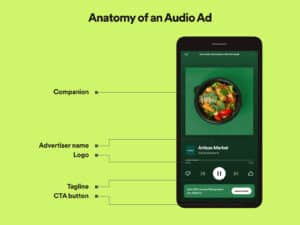Experiences refined for people
Experiences refined for people
The average U.S. adult spends 1 hour and 25 minutes immersed in digital audio every day. By 2026, projections show this audience will grow to 234 million listeners.
Programmatic audio advertising has great potential. Marketers can tap into a vast, engaged audience with highly targeted, immersive experiences on music streaming platforms, podcasts, and more.
Learn how this dynamic medium can elevate your brand’s presence, boost brand awareness, and deepen consumer engagement.
Programmatic audio automates the buying and selling of advertising space within digital audio content. This includes podcasts, digital radio, music streaming services, and other audio platforms.
Programmatic audio enables precise targeting, efficient ad delivery, and real-time optimization, making it an essential tool for marketers to reach specific audiences.
Programmatic audio uses advanced technologies and automated processes for precise targeting and efficient ad delivery across audio platforms.
Here’s how it works:
Why invest in programmatic audio?
“Consumers now dedicate more than 2 1/2 hours daily to audio consumption, a trend bolstered by the surge in podcast and digital audio engagement. Incorporating Programmatic Audio into your digital media arsenal presents a powerful opportunity to elevate brand visibility. Leveraging KORTX Intelligence, we pinpoint key areas of interest within your target demographic—preferred music or podcast genres or chosen streaming platforms—and tailor a bespoke audio strategy to resonate seamlessly.”

Programmatic audio advertising connects brands with their audiences through non-intrusive advertising.
Key benefits include:
Digital audio advertising surpasses traditional radio by offering unparalleled efficiency and scalability. By automating the ad buying process, advertisers rapidly deploy campaigns across digital audio platforms, achieving broader reach and consistent message delivery without traditional radio’s geographical and time constraints.
Terrestrial radio relies on self-reported listener information and geographic targeting by signal area. While over 80% of Americans listen to AM/FM radio weekly, traditional radio does not offer the ability to target as precisely as programmatic audio.
With programmatic audio, advertisers precisely segment their audience based on behavior, demographics, and listening preferences. This targeted approach tailors ads to individual listener profiles, enhancing the relevance and likelihood of engagement and response.
Curious about available segmentation?
Here are just a few offered by Spotify Advertising.

Targeted content resonates deeply with audiences, leading to higher engagement rates. On platforms like Spotify and Pandora, users often opt for free versions with ads, fostering an expectation and acceptance of advertising. This makes them more receptive to well-targeted messages.
74% of consumers have visited a company or product’s website after hearing an ad on a podcast they regularly listen to.
72% would consider a new product or service following a podcast ad.
65% have purchased due to a podcast ad.
54% have visited a store because of a podcast ad.
Source: https://www.eskimi.com/blog/audio-advertising-statistics
Programmatic audio uses real-time data and analytics, allowing advertisers to continuously monitor and adjust campaign performance. . This ongoing optimization improves each campaign, boosting return on ad spend and making the best use of resources..
89.8% of the US population owns a smartphone, and 25% of their time is spent streaming audio. Digital audio content is an essential channel for reaching engaged and receptive audiences.
Exploring the right audio advertising platforms is crucial for reaching your target audience.
At KORTX, we focus on a short list of curated audio platforms to help clients reach the right audience while maintaining a competitive CPM.
Measuring programmatic audio advertising is key to understanding your campaign’s success and informs future strategies. Like other forms of programmatic advertising, audio ads are typically purchased by CPM, with averages around $22+ across various platforms.
Programmatic audio primarily focuses on enhancing brand awareness. Tracking specific KPIs that reflect this goal is essential.
While the above metrics provide valuable insights, aligning audio KPIs with broader business goals and comparing them against other marketing channels is crucial.
Since direct actions from audio ads are not always immediate, tracking increases in website traffic, search performance, and sales can help attribute success to your audio campaigns. This holistic approach captures the full influence of your programmatic audio advertising efforts.
What is the relationship between programmatic and SEM/Paid Search?
“There is a correlation between programmatic audio efforts, paid search, and organic search. Programmatic awareness tactics often correspond with a lift in organic brand keyword impressions, paid search brand keyword impressions, return visits, and direct website visits.”

Programmatic audio advertising offers a variety of ad formats. Each format provides a unique opportunity for brands to connect and engage with their audience within the digital audio experience.
Pre-Roll Ads
Pre-roll ads are short advertisements before the primary audio content, capturing the listener’s initial attention. This format provides maximum exposure and delivers concise, powerful messages that prime listeners for the upcoming content.
Mid-Roll Ads
Mid-roll ads play at natural breaks within audio content, such as between podcast segments or songs in a playlist. They benefit from high listener engagement during content consumption and seem less intrusive due to their placement within the listening experience.
Post-Roll Ads
Post-roll ads play after the primary audio content concludes. They catch listeners who stay tuned until the end and can capitalize on the goodwill and engagement built during the content. This format suits calls to action or reinforces brand messages heard earlier.
Companion Ads
Companion ads are visual elements, like banners or logos, displayed on the audio player while the ad plays. These visual add-ons create a multi-sensory experience by combining audio and visual cues, enhancing brand recall, and offering a direct call-to-action (CTA) that listeners can click while engaged with the audio content.
Note: This technology is not available on all platforms.

On-episode podcast sponsorships cannot be purchased through programmatic audio. In these sponsorships, the host mentions the brand or product during the episode, creating a more personalized and integrated advertising experience. This approach often feels like a genuine endorsement, enhancing trust and connection with the audience.
While promising, implementing programmatic audio advertising presents several challenges and considerations that advertisers must navigate to strengthen their campaigns’ effectiveness.
Programmatic audio has diverse standards across platforms and occasional compatibility issues. Advertisers must be adaptable and knowledgeable about each platform’s requirements and capabilities to achieve seamless ad delivery and performance.
Compared to traditional radio advertising’s projected$10.49 billion in 2024, programmatic audio lags with an expected $7.12 billion. Due to this growth lag, teams may lack detailed knowledge about programmatic audio’s nuances and potential.
Unlike visual digital ads, where direct clicks and interactions are easily traceable, audio ads often lack a clear, direct action path for listeners. This makes measuring the precise effect on brand awareness, website traffic, and ultimate conversions challenging. Advertisers need to employ sophisticated tracking methods and consider indirect metrics to gauge the success of their audio campaigns.
How can we ensure our programmatic audio ads are effective if our team lacks experience?
“When purchasing programmatic audio through a DSP, you need to know where and what kind of audio you want your ads to appear on. Alternatively, you can hire an experienced partner to navigate the landscape. Partnering with experts can leverage this medium’s potential if your team is not prepared to plan, optimize, and run audio ads.”

Emerging technologies and changing user behaviors are shaping the future of programmatic audio advertising, promising new ways for brands to connect with audiences.
What advice would you give to brands looking to integrate podcast advertising into their marketing strategies?
“The true value is in finding podcasts that have a hyper engaged audience that trusts ad reads coming from the hosts aren’t just a money grab and instead are products and services the hosts actually believe in. My co-hosts and I passed on some advertising opportunities early on due to the product not aligning with us. This was a strategic move to ensure future ad deals would deliver the strongest impact for brands we partner with as well as our listeners.”

By following these tips, you can navigate the complexities of programmatic audio advertising and create successful campaigns that resonate with your customer base.
Programmatic audio offers precise targeting, higher engagement, and seamless platform integration. As this medium grows, embracing it means tapping into a vast, attentive audience ready for immersive experiences.
About the Author
Brandon Pollard is the Director of Ad Operations at KORTX. He enjoys cloud rap, soccer, and traveling.
From us to your inbox weekly.